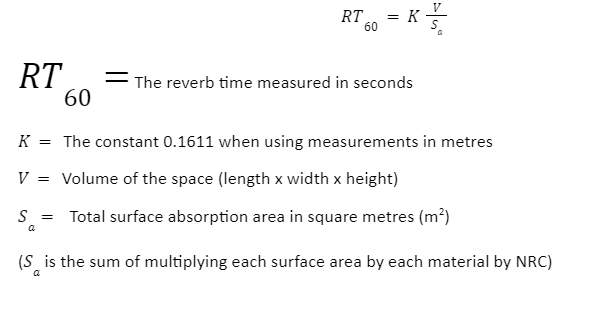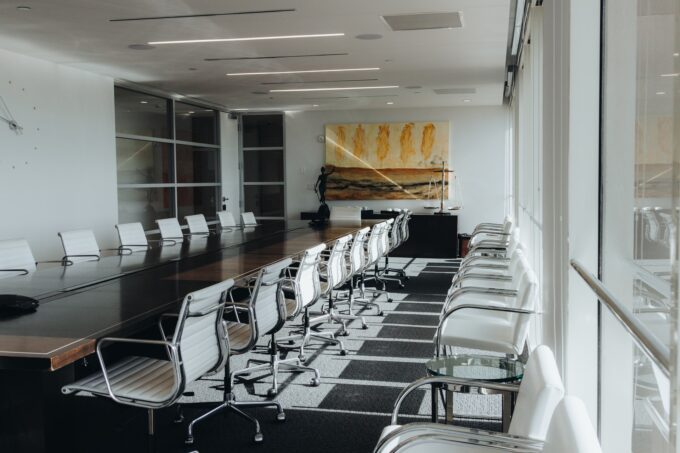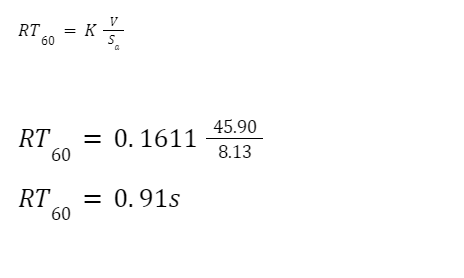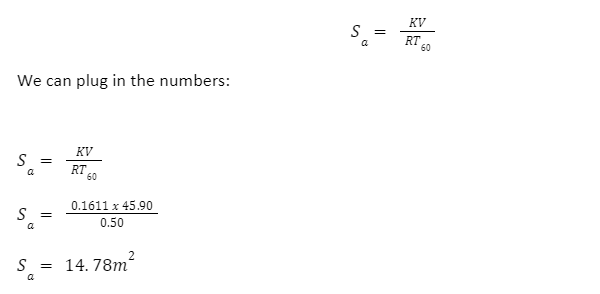Managing reverb is essential in almost all spaces. From classrooms to boardrooms, offices to hospitals, echoes and noise can cause serious problems.
Very simply, reverberation is reflections of sound. When sound is emitted from a source it usually moves outwards omnidirectionally until it meets reflective surfaces. Where too many reflections occur, an uncomfortable environment is created. This is when acoustic treatment is needed to absorb some of the sound waves from the surfaces to reduce the number of waves being reflected.
Reverb is measured in Seconds: RT followed by a number (usually 60) shows the length of time in seconds for the measured sound to drop by x number of decibels. It is usually represented as RT60
To calculate reverb time we need to know the following facts about a space.

Source: pexels.com
Volume: The volume of the room (lwh) is used in the calculation
Absorbing surfaces and the areas of these: The contents of the room and what they are made of. This is important as different materials absorb different amounts of sound which affects reverb times. Carpet, for example, absorbs a lot more sound than a concrete floor.
Co-efficient values for the surface materials: Each material has a relating co-efficient (referred to as NRC), between 0 and 1. A coefficient of 1 shows that 100% of sound that hits the surface will be absorbed and 0% will be reflected. An NRC of 0.4 shows that 40% of sound will be absorbed and 60% reflected
We also need:
K- a constant for the formula. Where calculating the reverb time using measurements of metres, this value is 0.1611
The formula used to calculate the reverb time below is the end result of other formulas which do not need to be looked at here.
Sabine’s Formula

An example of calculating reverb time.
Key pieces of information

Source: unsplash.com
- We have a room which measures 5 metres in length, 2.7m in height and has a width of 3.4m
- The floor is carpet, the ceiling and walls are plasterboard. There is a wooden door which measures 1.5 x 2m and a glass window on one of the walls measuring 2x1m.
- The room is going to be used for video conferencing
Once the required information is collated it is possible to input some of the numbers into the formula.
We know that K=0.1611 and we can calculate the volume of the room easily to be 45.90m3

To calculate the surface absorption we need to use an NRC (see appendix for a more detailed list). For this calculation we will use the following NRC ratings
For this calculation we will use the following NRC ratings
| Plasterboard | 0.02 |
| Glass | 0.03 |
| Wood | 0.04 |
| Carpet | 0.40 |
We need to calculate the area of each material:
| Plasterboard* | 57.36m2 |
| Glass | 2m2 |
| Wood | 3m2 |
| Carpet | 17m2 |
| Ceiling | 17m2 |
| Wall 1 | 13.50m2 |
| Wall 2 | 13.50m2 |
| Wall 3 | 9.18m2 |
| Wall 4 | 9.18m2 |
| Minus Glass | 2m2 |
| Minus Door | 3m2 |
| 57.36m2 |
Sa calculation:
| Plasterboard = 57.36 x 0.02 | 1.15 |
| Glass = 2 x 0.03 | 0.06 |
| Wood = 3 x 0.04 | 0.12 |
| Carpet = 17 x 0.40 | 6.80 |
| Sum | 8.13m2 |
We can now plug this number into the formula and complete the calculation:

This shows that the current reverb time in the room is 0.91 seconds.
The client’s acoustician has requested a reverb time of 0.5s to give extra protection against noise levels during video calls
To calculate how much treatment is needed for the space, we now need to work out Sa as the subject of the formula with the reverb time being a known number at 0.50s.
The formula is therefore rearranged as follows:

This shows us the total absorption required for achieve a reverb time of 0.50s is 14.78m2. As we already have 8.13m2 in the room (used in the reverb time calculation) we can calculate that the required acoustic treatment would need to be 14.78-8.13=6.65m2 of absorption.
Treatment

Source: offandrunningrealestate.com
It is important to know that the square metre number for this calculation is used to describe the required amount of absorption area at an NRC of 1.
If an acoustic product has an NRC of 0.40 we need to increase the number of panels accordingly. To do this we would divide the required square meterage by the NRC of the product. For example, in this example we would divide 6.65 by 0.4 showing us that we would need 16.63m2 of this acoustic product
Acoustic treatments come in many shapes and sizes, are made from different materials and offer different levels of absorption. Below is a table with a brief overview of the standard types.
| Treatment Area | Materials | NRC | Product Examples |
| Walls | PET | 0.40 | Autex Cube
AllSfär Panels |
| Walls | Glass Wool | 0.50 – 1 | Ecophon Solo |
| Walls | Fabric Wrapped Panels | 0.50- 1 | Autex Quietspace |
| Walls | Wood Wool | 0.40-0.75 | BAUX |
| Ceiling | Glass Wool | 0.50 – 1 | Ecophon Solo |
| Ceiling | PET | 0.40-0.75 | Autex Frontier
Autex Horizon |
Some acoustic products require specialist installation knowledge, whereas most fabric wrapped acoustic panels are relatively simple to install, are light weight and are often available with a peel-and-stick backing making DIY acoustic panel installation easy and efficient on time.
Appendix:
Material NRC.
The NRC (noise reduction co-efficient) is the average sound absorption across the frequency bands , 250, 500, 1000, 2000Hz.
This table provides a brief overview of the most commonly used materials we come across when dealing with interior acoustics.
| Material | NRC |
| Walls, hard surfaces average | 0.03 |
| (brick walls, plaster, hard floors, etc.) | |
| Walls, rendered brickwork | 0.03 |
| Rough concrete | 0.03 |
| Smooth unpainted concrete | 0.02 |
| Rough lime wash | 0.04 |
| Smooth brickwork with flush pointing, | 0.02 |
| painted | |
| Smooth brickwork, 10 mm deep | 0.15 |
| pointing, pit sand mortar | |
| Brick wall, stuccoed with a rough finish | 0.04 |
| Ceramic tiles with a smooth surface | 0.02 |
| Limestone walls | 0.04 |
| Reverberation chamber walls | 0.02 |
| Concrete floor | 0.03 |
| Marble floor | 0.02 |
| Lightweight constructions and linings | |
| Material | |
| 2 * 13 mm plasterboard on steel frame, | 0.06 |
| 50 mm mineral wool in cavity, surface | |
| painted | |
| Wooden lining, 12 mm fixed on frame | 0.18 |
| Glazing | |
| Material | |
| Single pane of glass, 3 mm | 0.03 |
| Glass window, 0.68 kg/m2 | 0.04 |
| Lead glazing | 0.12 |
| Double glazing, 2-3 mm glass, | 0.03 |
| > 30 mm gap | |
| Double glazing, 2-3 mm glass, | 0.04 |
| 10 mm gap | |
| Double glazing, lead on the inside | 0.16 |
| Wood | |
| Material | |
| Wood, 1.6 cm thick, | 0.10 |
| on 4 cm wooden planks | |
| Thin plywood panelling | 0.11 |
| 16 mm wood on 40 mm studs | 0.10 |
| Audience floor, 2 layers, | 0.05 |
| 33 mm on sleepers over concrete | |
| Wood, stage floor, 2 layers, | 0.06 |
| 27 mm over airspace | |
| Solid wooden door | 0.09 |
| Floor coverings | |
| Material | |
| Linoleum, asphalt, rubber, | 0.03 |
| or cork tile on concrete | |
| Cotton carpet | 0.57 |
| Loop pile tufted carpet, 1.4 kg/m2, | 0.59 |
| 9.5 mm pile height: On hair pad, | |
| 3.0 kg/m2 | |
| Thin carpet, cemented to concrete | 0.17 |
| 6 mm pile carpet bonded to | 0.25 |
| closed-cell foam underlay | |
| 306 Annex | |
| Floor coverings (cont’d) | |
| Material | |
| 6 mm pile carpet bonded to open-cell | 0.38 |
| foam underlay | |
| 9 mm tufted pile carpet on felt underlay | 0.43 |
| Needle felt 5 mm stuck to concrete | 0.13 |
| 10 mm soft carpet on concrete | 0.21 |
| Hairy carpet on 3 mm felt | 0.30 |
| 5 mm rubber carpet on concrete | 0.09 |
| Carpet 1.35 kg/m2, on hair felt | 0.55 |
| or foam rubber | |
| Cocos fibre roll felt, 29 mm thick | 0.29 |
| (unstressed), reverse side clad | |
| with paper, 2.2 kg/m2, 2 Rayl |







